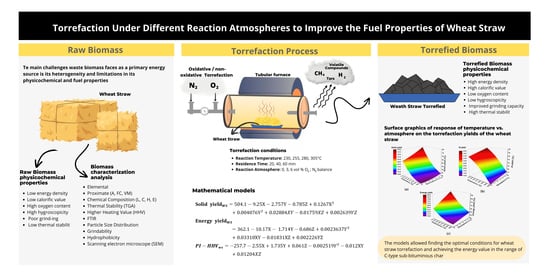Torrefaction under Different Reaction Atmospheres to Improve the Fuel Properties of Wheat Straw
Abstract
:1. Introduction
2. Materials and Methods
2.1. Materials
2.2. Experimental Design
2.3. Torrefaction Procedure
2.4. Torrefaction Yield
2.5. Torrefaction Optimal Conditions
2.6. Comparative Analysis
2.6.1. Proximate Analysis
2.6.2. Elemental Analysis
2.6.3. Chemical Composition Analysis
2.6.4. Higher Heating Value (HHV)
2.6.5. Grindability
2.6.6. Particle Size Distribution
2.6.7. Hydrophobicity (Moisture Reabsorption)
2.6.8. Microscopic Analysis
2.6.9. Thermal Stability
2.6.10. FTIR Analysis
3. Results
3.1. Torrefaction Yield
3.2. Torrefaction Theoric-Optimal Conditions
3.3. Torrefaction Experimental Optimal Conditions
3.4. Comparative Analysis of Fuel Properties
3.4.1. Proximate Analysis
3.4.2. Elemental Analysis
3.4.3. Chemical Composition Analysis
3.4.4. Higher Heating Value (HHV)
3.4.5. Grinding Analysis
3.4.6. Particle Distribution Analysis
3.4.7. Thermogravimetric Analysis
3.4.8. Moisture Absorption Analysis
3.4.9. FTIR Analysis
3.4.10. SEM Analysis
4. Conclusions
Author Contributions
Funding
Data Availability Statement
Acknowledgments
Conflicts of Interest
References
- Zhang, L.; Wang, Z.; Ma, J.; Kong, W.; Yuan, P.; Sun, R.; Shen, B. Analysis of functionality distribution and microstructural characteristics of upgraded rice husk after undergoing non-oxidative and oxidative torrefaction. J. Fuel 2022, 310, 122477. [Google Scholar] [CrossRef]
- IEA, International Energy Agency. Total Energy Supply (TES) by Source for 2019. Available online: www.iea.org (accessed on 12 March 2021).
- Masera, O.; Coralli, F.; García, C. La Bioenergía en México. Situación Actual y Perspectivas; Red Mexicana de Bioenergía, A.C.: Morelia, México, 2011. [Google Scholar]
- Montero, G.; Coronado, M.A.; Torres, R.; Jaramillo, B.E.; Garcia, C.; Stoytcheva, M.; Vázquez, A.M.; León, J.A.; Lambert, A.A.; Valenzuela, E. Higher heating value determination of wheat straw from Baja California, Mexico. J. Energy 2016, 109, 612–619. [Google Scholar] [CrossRef]
- SIAP, Servicio de Información Agroalimentaria y Pesquera. Producción Agrícola: Resumen Nacional por Estado. Available online: https://www.gob.mx/siap (accessed on 10 July 2022).
- DD CEN/TS 14961:2005; Solid Biofuels—Fuel Specifications and Classes. European Committee for Standardization: Brussels, Belgium, 2005; p. 46.
- Cheng, X.; Huang, Z.; Wang, Z.; Ma, C.; Chen, S. A novel on-site wheat straw pretreatment method: Enclosed torrefaction. Bioresour. Technol. 2019, 281, 48–55. [Google Scholar] [CrossRef]
- Singh, R.K.; Sarkar, A.; Chakraborty, J.P. Effect of torrefaction on the physicochemical properties of eucalyptus derived biofuels: Estimation of kinetic parameters and optimizing torrefaction using response surface methodology (RSM). Energy 2020, 198, 117369. [Google Scholar] [CrossRef]
- Chen, D.; Chen, F.; Cen, K.; Cao, X.; Zhang, J.; Zhou, J. Upgrading rice husk via oxidative torrefaction: Characterization of solid, liquid, gaseous products and a comparison with non-oxidative torrefaction. J. Fuels 2020, 275, 117936. [Google Scholar] [CrossRef]
- Zhao, Z.; Feng, S.; Zhao, Y.; Wang, Z.; Ma, J.; Xu, L.; Yang, J.; Shen, B. Investigation on the fuel quality and hydrophobicity of upgraded rice husk derived from various inert and oxidative torrefaction conditions. Renew. Energy 2022, 189, 1234–1248. [Google Scholar] [CrossRef]
- Bridgeman, T.G.; Jones, J.M.; Shield, I.; Williams, P.T. Torrefaction of reed canary grass, wheat straw and willow to enhance solid fuel qualities and combustion properties. J. Fuel 2008, 87, 844–856. [Google Scholar] [CrossRef]
- Cheng, W.; Zhu, Y.; Zhang, W.; Jiang, H.; Hu, J.; Zhang, X.; Yang, H.; Chen, H. Effect of oxidative torrefaction on particulate matter emission from agricultural biomass pellet combustion in comparison with non-oxidative torrefaction. Renew. Energy 2022, 189, 39–51. [Google Scholar] [CrossRef]
- Li, G.; Hu, R.; Hao, Y.; Yang, T.; Li, L.; Luo, Z.; Xie, L.; Zhao, C.; Liu, C.; Shen, G. CO2 and air pollutant emissions from bio-coal briquettes. Environ. Technol. Innov. 2023, 29, 102975. [Google Scholar] [CrossRef]
- Guo, D.; Cui, B.; Chen, Z.; Yan, W.; Ji, B.; Zhang, Q.; Liu, Y.; Luo, S.; Hu, M.; Ruan, R. Biomass enhances the reduction of oxidized pellets with carbon monoxide. Bioresour. Technol. 2021, 331, 124973. [Google Scholar] [CrossRef] [PubMed]
- Torres, R.; Valdez, B.; Beleño, M.T.; Coronado, M.A.; Stoytcheva, M.; García, C.; Rojano, B.A.; Montero, G. Char production with high-energy value and standardized properties from two types of biomass. Biomass Convers. Biorefin. 2021, 13, 4831–4847. [Google Scholar] [CrossRef]
- Wang, Q.; Sun, S.; Zhang, X.; Liu, H.; Sun, B.; Guo, S. Influence of air oxidative and non-oxidative torrefaction on the chemical properties of corn stalk. Bioresour. Technol. 2021, 332, 125120. [Google Scholar] [CrossRef] [PubMed]
- Zhang, C.; Wang, C.; Cao, G.; Chen, W.H.; Ho, S. Comparison and characterization of property variation of microalgal biomass with non-oxidative and oxidative torrefaction. J. Fuel 2019, 246, 375–385. [Google Scholar] [CrossRef]
- Uemura, Y.; Sellappah, V.; Trinh, T.H.; Hassan, S.; Tanoue, K.I. Torrefaction of empty fruit bunches under biomass combustion gas atmosphere. Bioresour. Technol. 2017, 243, 107–117. [Google Scholar] [CrossRef]
- Zhang, C.; Ho, S.H.; Chen, W.H.; Fu, Y.; Chang, J.S.; Bi, X. Oxidative torrefaction of biomass nutshells: Evaluations of energy efficiency as well as biochar transportation and storage. Appl. Energy 2019, 235, 428–441. [Google Scholar] [CrossRef]
- Chen, W.H.; Lu, K.M.; Liu, S.H.; Tsai, C.M.; Lee, W.J.; Lin, T.C. Biomass torrefaction characteristics in inert and oxidative atmospheres at various superficial velocities. Bioresour. Technol. 2013, 146, 152–160. [Google Scholar] [CrossRef]
- Rousset, P.; Macedo, L.; Commandré, J.M.; Moreira, A. Biomass torrefaction under different oxygen concentrations and its effect on the composition of the solid by-product. J. Anal. Appl. Pyrolysis 2012, 96, 86–91. [Google Scholar] [CrossRef] [Green Version]
- Zhang, C.; Ho, S.H.; Chen, W.H.; Xie, Y.; Liu, Z.; Chang, J.S. Torrefaction performance and energy usage of biomass wastes and their correlations with torrefaction severity index. Appl. Energy 2018, 220, 598–604. [Google Scholar] [CrossRef]
- Chen, D.; Zheng, Z.; Fu, K.; Zeng, Z.; Wang, J.; Lu, M. Torrefaction of biomass stalk and its effect on the yield and quality of pyrolysis products. J. Fuel 2015, 159, 27–32. [Google Scholar] [CrossRef]
- Arias, B.; Pevida, C.; Fermoso, J.; Plaza, M.G.; Rubiera, F.; Pis, J.J. Influence of torrefaction on the grindability and reactivity of woody biomass. Fuel Process. Technol. 2008, 89, 169–175. [Google Scholar] [CrossRef] [Green Version]
- Agarwal, A.K.; Pandey, A.; Gupta, A.K.; Aggarwal, S.K.; Kushari, A. Novel Combustion Concepts for Sustainable Energy Development; Springer: New Delhi, India, 2014. [Google Scholar] [CrossRef]
- Alvarez, A.; Nogueiro, D.; Pizarro, C.; Matos, M.; Bueno, J.L. Non-oxidative torrefaction of biomass to enhance its fuel properties. J. Energy 2018, 158, 1–8. [Google Scholar] [CrossRef]
- Shankar, T.J.; Boardman, R.D.; Wright, C.T.; Hess, J.R. Some chemical compositional changes in Miscanthus and white oak sawdust samples during torrefaction. Energies 2012, 5, 3928–3947. [Google Scholar] [CrossRef] [Green Version]
- Na, B.I.; Ahn, B.J.; Lee, J.W. Changes in chemical and physical properties of yellow poplar (Liriodendron tulipifera) during torrefaction. Wood Sci. Technol. 2015, 49, 257–272. [Google Scholar] [CrossRef]
- Azocar, L.; Hermosilla, N.; Gay, A.; Rocha, S.; Díaz, J.; Jara, P. Brown pellet production using wheat straw from southern cities in Chile. J. Fuel 2019, 237, 823–832. [Google Scholar] [CrossRef]
- Kim, Y.H.; Na, B.I.; Ahn, B.J.; Lee, H.W.; Lee, J.W. Optimal condition of torrefaction for high energy density solid fuel of fast growing tree species. Korean J. Chem. Eng. 2015, 32, 1547–1553. [Google Scholar] [CrossRef]
- Ho, S.H.; Zhang, C.; Chen, W.H.; Shen, Y.; Chang, J.S. Characterization of biomass waste torrefaction under conventional and microwave heating. Bioresour. Technol. 2018, 264, 7–16. [Google Scholar] [CrossRef]
- Barrera, R.; Pérez, J.F.; Salazar, C. Carbones colombianos: Clasificación y caracterización termoquímica para aplicaciones energéticas. Rev. ION 2014, 27, 43–54. [Google Scholar]
- Bai, X.; Wang, G.; Sun, Y.; Yu, Y.; Liu, J.; Wang, G.; Wang, Z. Effects of combined pretreatment with rod-milled and torrefaction on physicochemical and fuel characteristics of wheat straw. Bioresour. Technol. 2018, 267, 38–45. [Google Scholar] [CrossRef]
- Kartal, F.; Özveren, U. Investigation of an integrated circulating fluidized bed gasifier/steam turbine/proton exchange membrane (PEM) fuel cell system for torrefied biomass and modeling with artificial intelligence approach. Energy Convers. Manag. 2022, 263, 115718. [Google Scholar] [CrossRef]
- Chen, Y.C.; Chen, W.H.; Lin, B.J.; Chang, J.S.; Ong, H.C. Impact of torrefaction on the composition, structure, and reactivity of a microalga residue. Appl. Energy 2016, 181, 110–119. [Google Scholar] [CrossRef]
- Shang, L.; Ahrenfeldt, J.; Holm, J.K.; Sanadi, A.R.; Barsberg, S.T.; Thomsen, T.; Stelte, W.; Henriksen, U.B. Changes of chemical and mechanical behavior of torrefied wheat straw. Biomass Bioenergy 2012, 40, 63–70. [Google Scholar] [CrossRef] [Green Version]
- Gominho, J.; Lourenço, A.; Miranda, I.; Pereira, H. Chemical and fuel properties of stumps biomass from Eucalyptus globulus plantations. Ind. Crops Prod. 2012, 39, 12–16. [Google Scholar] [CrossRef]
- Stelte, W.; Nielsen, N.P.K.; Hansen, H.O.; Dahl, J.; Shang, L.; Sanadi, A.R. Pelletizing properties of torrefied wheat straw. Biomass Bioenergy 2013, 53, 105–112. [Google Scholar] [CrossRef]
- Da Silva, C.M.S.; Vital, B.R.; Carneiro, A.C.O.; Costa, E.V.; Magalhães, M.; Trugilho, P.F. Structural and compositional changes in eucalyptus wood chips subjected to dry torrefaction. Ind. Crops Prod. 2017, 109, 598–602. [Google Scholar] [CrossRef]
- Bergman, P.C.; Boersma, A.R.; Zwart, R.W.R.; Kiel, J.H.A. Torrefaction for Biomass Co-Firing in Existing Coal-Fired Power Stations; ECN-C-05-013; Energy Research Centre of the Netherlands: Amsterdam, The Netherlands, 2005. Available online: https://www.osti.gov/etdeweb/biblio/20670903 (accessed on 6 May 2022).
- Chen, W.H.; Lin, B.J.; Lin, Y.Y.; Chu, Y.S.; Ubando, A.T.; Show, P.L.; Ong, H.C.; Chang, J.S.; Ho, S.H.; Culaba, A.B.; et al. Progress in biomass torrefaction: Principles, applications and challenges. Prog. Energy Combust. 2021, 82, 100887. [Google Scholar] [CrossRef]
- Wu, K.T.; Tsai, C.J.; Chen, C.S.; Chen, H.W. The characteristics of torrefied microalgae. Appl. Energy 2012, 100, 52–57. [Google Scholar] [CrossRef]
- Bridgeman, T.; Jones, J.; Williams, A.; Waldron, D. An investigation of the grindability of two torrefied energy crops. J. Fuel 2010, 89, 3911–3918. [Google Scholar] [CrossRef] [Green Version]
- Ibrahim, R.H.; Darvell, L.I.; Jones, J.M.; Williams, A. Physicochemical characterisation of torrefied biomass. J. Anal. Appl. Pyrolysis 2013, 103, 21–30. [Google Scholar] [CrossRef]
- Lu, Z.; Xie, T.; Chen, H.; Li, L.; Li, S.; Lu, Y.; Hu, X. Evaluation of effects of freezing pretreatment on the grindability, energy consumption, and chemical composition of wheat straw. Renew. Energy 2020, 151, 21–29. [Google Scholar] [CrossRef]
- Nepal, R.; Kim, H.; Poudel, J.; Oh, S.C. A study on torrefaction of spent coffee ground to improve its fuel properties. J. Fuel 2022, 318, 123643. [Google Scholar] [CrossRef]
- Chen, W.H.; Lu, K.M.; Tsai, C.M. An experimental analysis on property and structure variations of agricultural wastes undergoing torrefaction. Appl. Energy 2012, 100, 318–325. [Google Scholar] [CrossRef]
- Wilk, M.; Magdziarz, A.; Kalemba, I. Characterisation of renewable fuels torrefaction process with different instrumental techniques. J. Energy 2015, 87, 259–269. [Google Scholar] [CrossRef]
- Nam, H.; Capareda, S. Experimental investigation of torrefaction of two agricultural wastes of different composition using RSM (response surface methodology). Energy 2015, 91, 507–516. [Google Scholar] [CrossRef]
- Manatura, K. Inert torrefaction of sugarcane bagasse to improve its fuel properties. Case Stud. Therm. Eng. 2020, 19, 100623. [Google Scholar] [CrossRef]
- Satpathy, S.K.; Tabil, L.G.; Meda, V.; Naik, S.N.; Prasad, R. Torrefaction of wheat and barley straw after microwave heating. J. Fuel 2014, 124, 269–278. [Google Scholar] [CrossRef]
- Pimchuai, A.; Dutta, A.; Basu, P. Torrefaction of agriculture residue to enhance combustible properties. Energy Fuel 2010, 24, 4638–4645. [Google Scholar] [CrossRef]
- Kongto, P.; Palamanit, A.; Chaiprapat, S.; Tippayawong, N. Enhancing the fuel properties of rubberwood biomass by moving bed torrefaction process for further applications. Renew. Energy 2021, 170, 703–713. [Google Scholar] [CrossRef]
- Arteaga, L.E.; Grandón, H.; Flores, M.; Segura, C.; Kelley, S.S. Steam torrefaction of Eucalyptus globulus for producing black pellets: A pilot-scale experience. Bioresour. Technol. 2017, 238, 194–204. [Google Scholar] [CrossRef]
- Rousset, P.; Davrieux, F.; Macedo, L.; Perré, P. Characterisation of the torrefaction of beech wood using NIRS: Combined effects of temperature and duration. Biomass Bioenergy 2011, 35, 1219–1226. [Google Scholar] [CrossRef]
- Martín, M.A.; Ronda, A.; Zamora, M.C.; Calero, M. Torrefaction of olive tree pruning: Effect of operating conditions on solid product properties. J. Fuel 2017, 202, 109–117. [Google Scholar] [CrossRef]
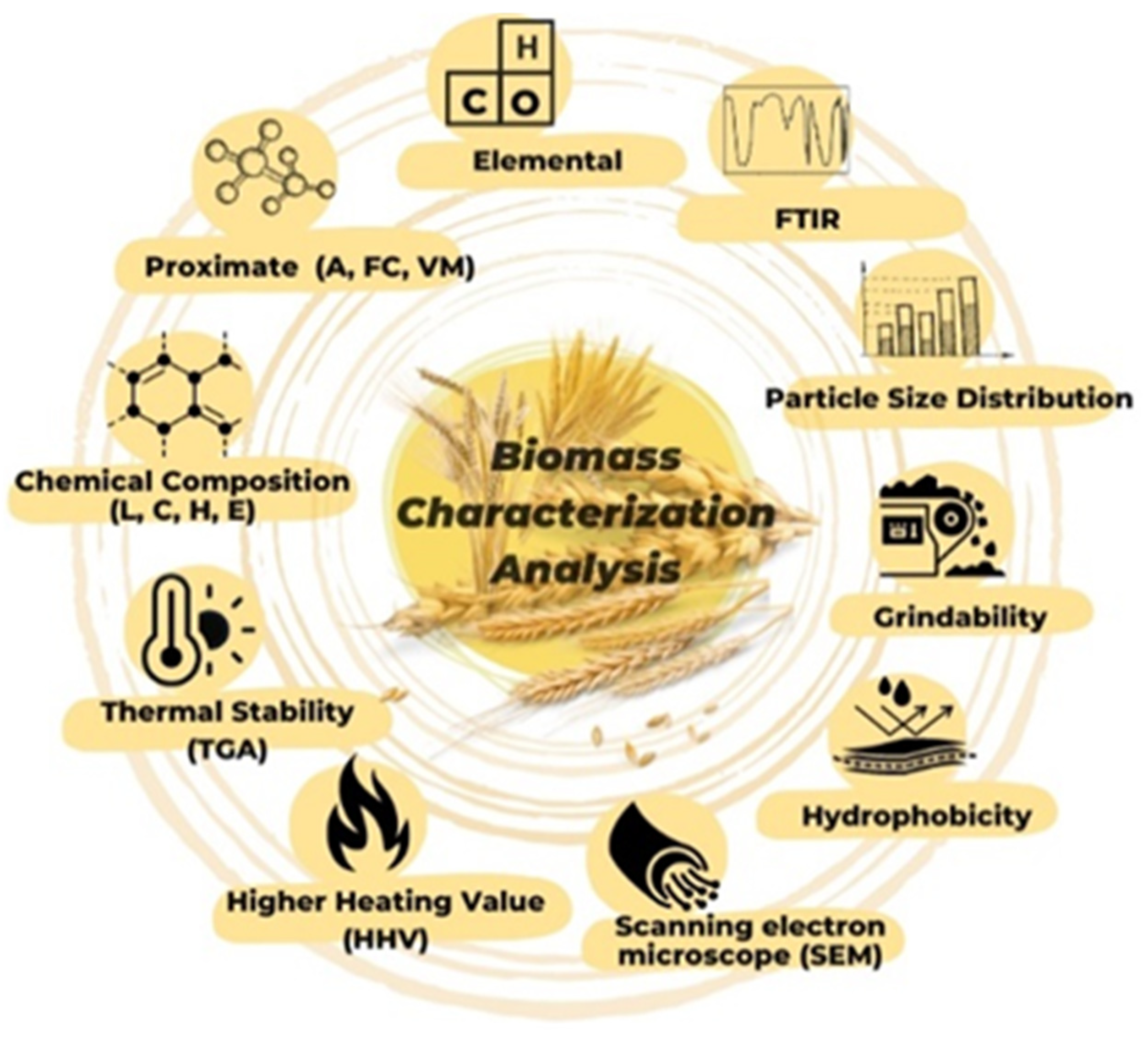
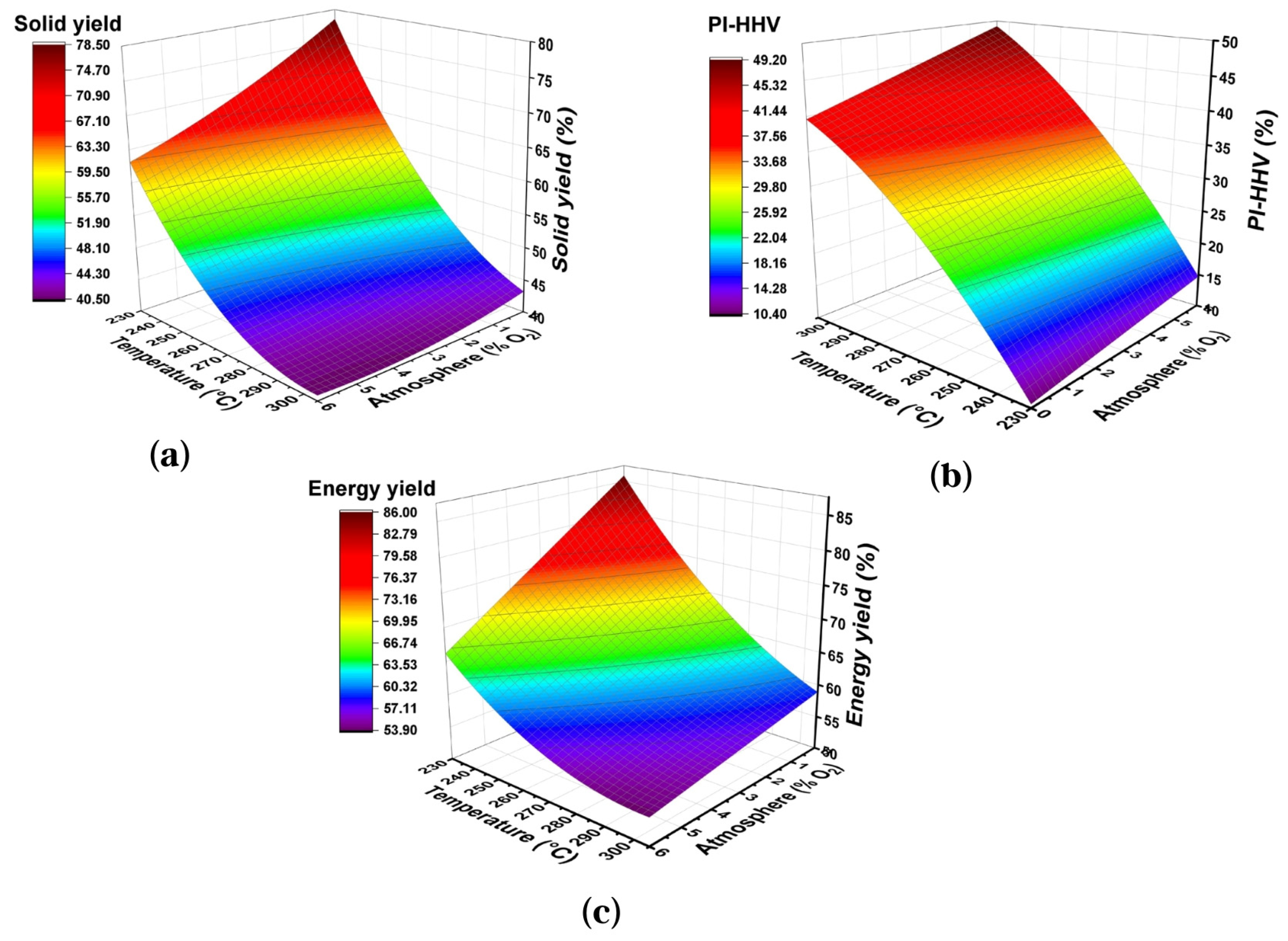


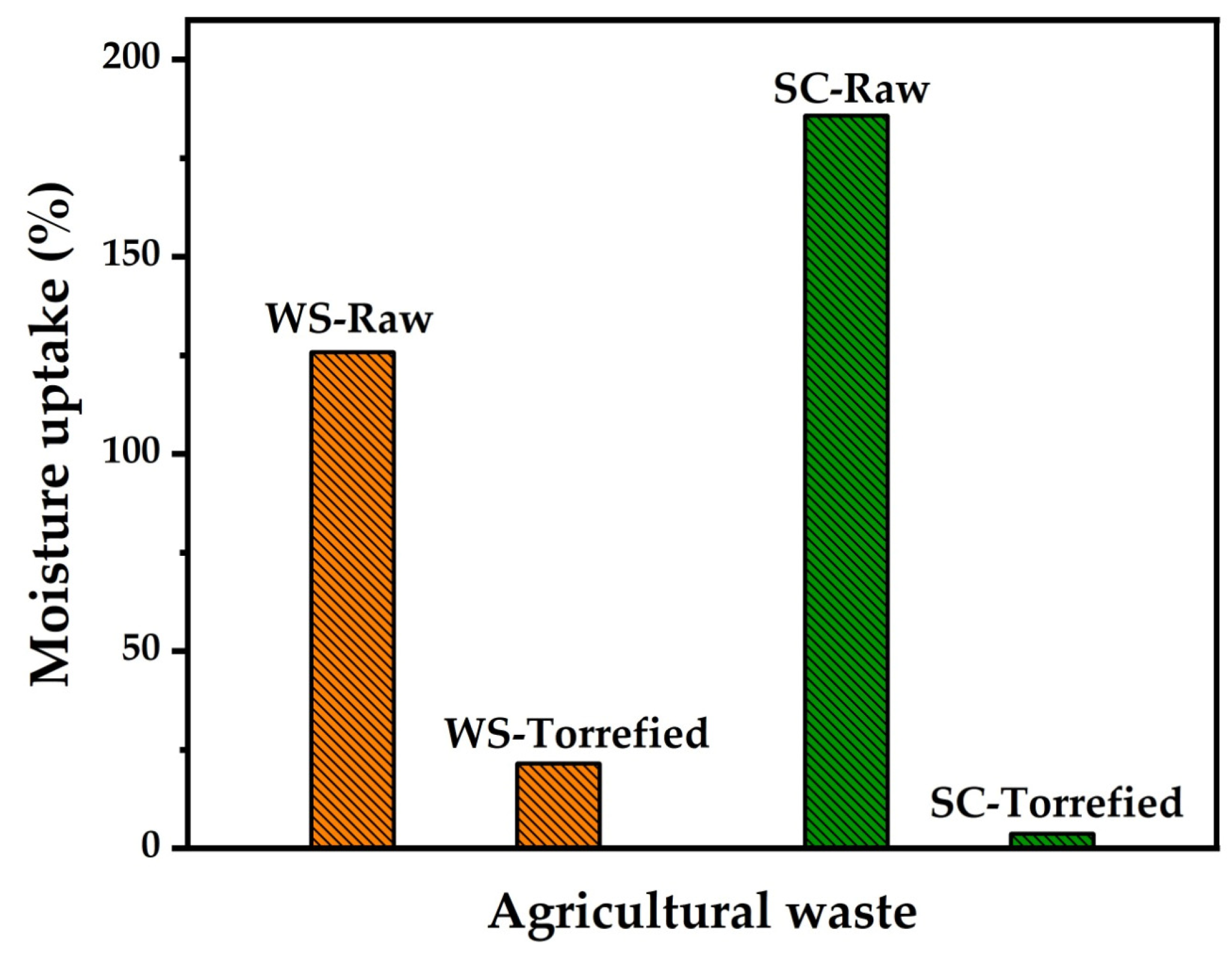
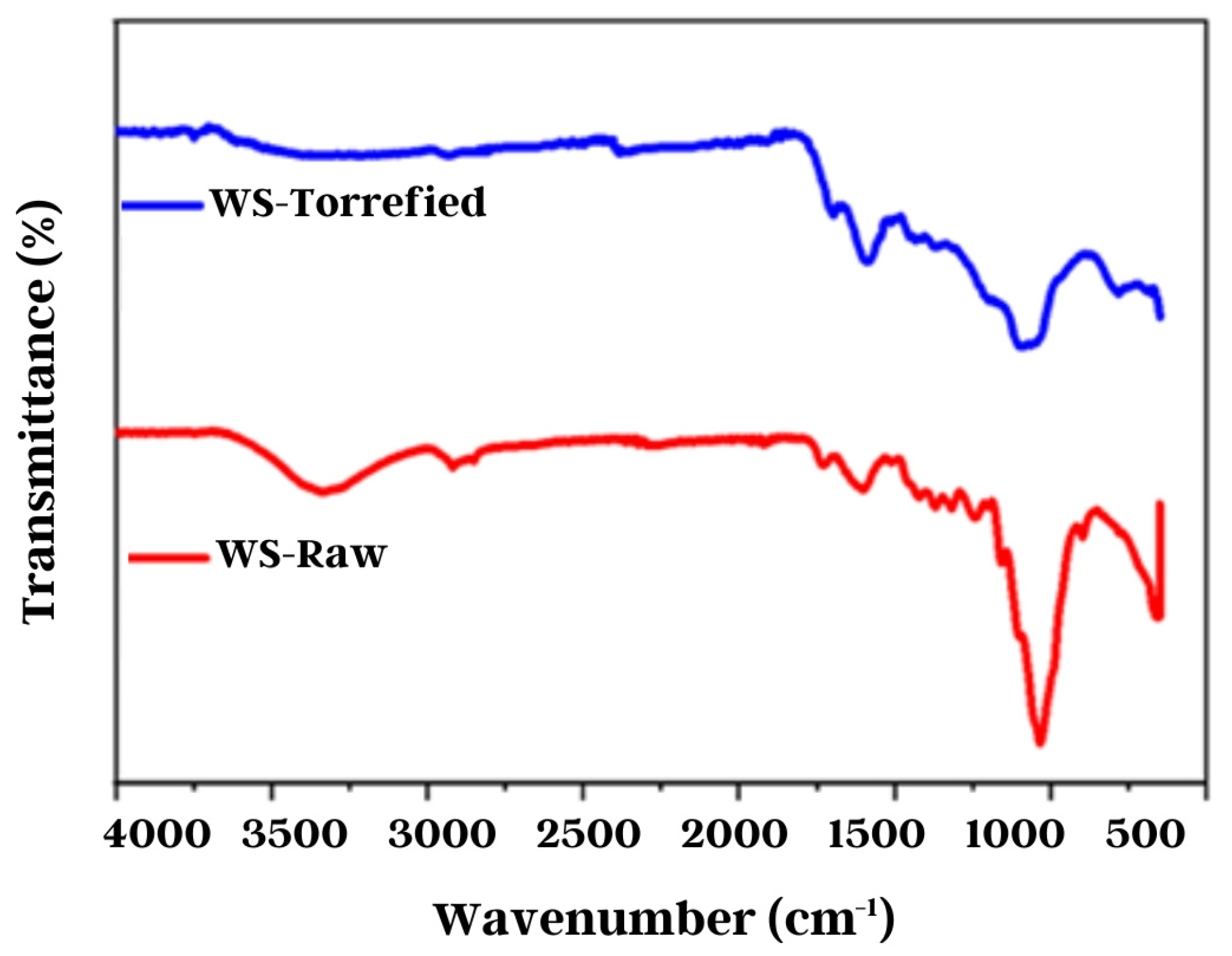
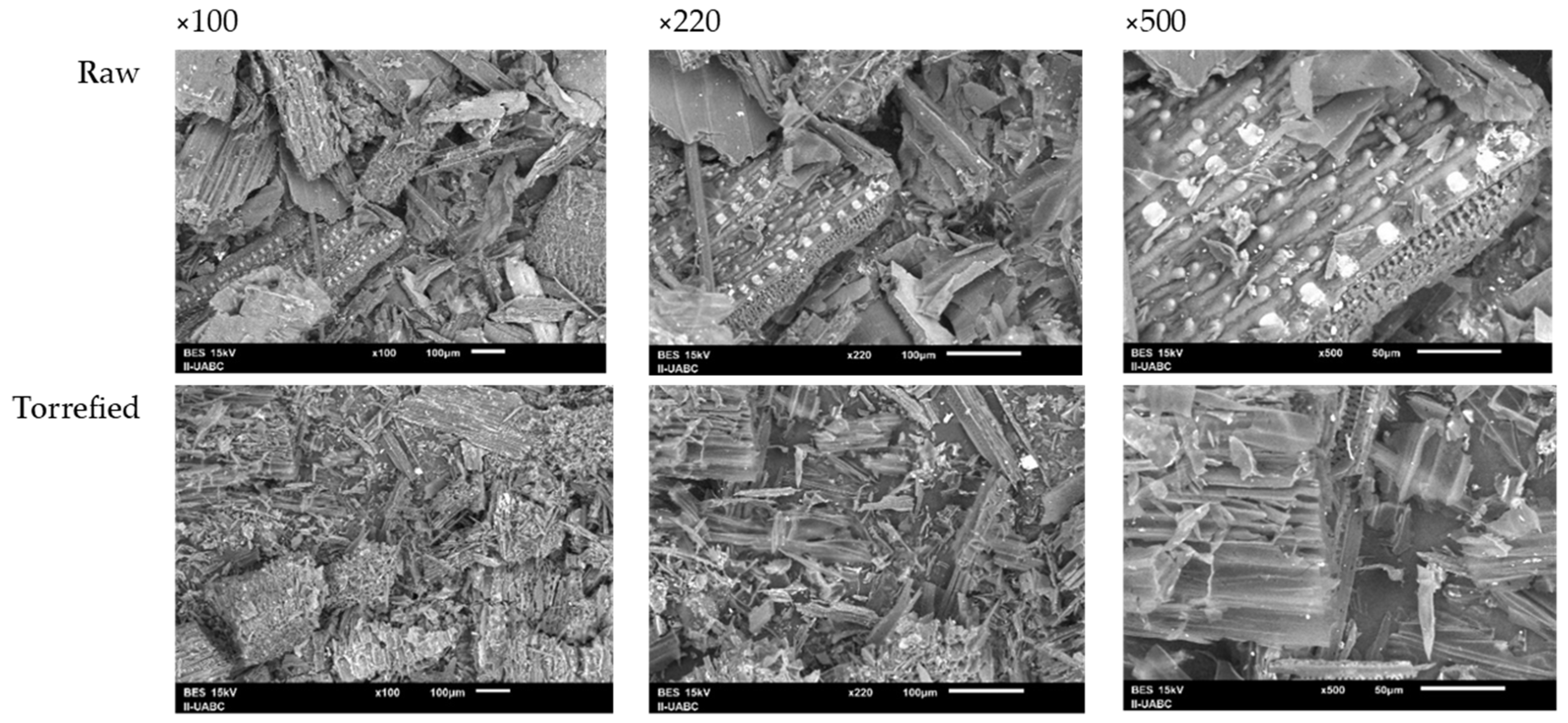
| O2 | 0% | 3% | 6% | ||||||
|---|---|---|---|---|---|---|---|---|---|
| Temperature (°C) | Time (min) | ||||||||
| 20 | 40 | 60 | 20 | 40 | 60 | 20 | 40 | 60 | |
| Wheat Straw | |||||||||
| Solid yield | |||||||||
| 230 | 82.12 | 78.01 | 76.37 | 73.3 | 68.93 | 62.93 | 69.13 | 63.88 | 55.58 |
| 255 | 64.87 | 62.30 | 59.40 | 58.94 | 53.14 | 50.64 | 54.20 | 52.34 | 45.71 |
| 280 | 48.28 | 47.75 | 46.38 | 47.03 | 45.03 | 43.84 | 46.43 | 43.11 | 41.11 |
| 305 | 43.91 | 43.39 | 42.65 | 43.00 | 41.63 | 40.46 | 41.48 | 38.89 | 37.19 |
| PI-HHV | |||||||||
| 230 | 8.29 | 10.75 | 11.36 | 11.20 | 11.34 | 15.64 | 10.53 | 12.61 | 16.27 |
| 255 | 21.72 | 22.03 | 26.02 | 22.19 | 23.72 | 29.08 | 24.40 | 27.56 | 33.07 |
| 280 | 32.29 | 32.04 | 33.27 | 33.87 | 35.95 | 37.48 | 36.55 | 40.49 | 42.38 |
| 305 | 36.58 | 38.96 | 40.43 | 40.75 | 43.90 | 46.24 | 44.72 | 47.16 | 49.24 |
| Energy yield | |||||||||
| 230 | 88.93 | 86.40 | 85.05 | 82.22 | 76.74 | 72.10 | 76.27 | 71.94 | 64.62 |
| 255 | 78.96 | 76.02 | 74.85 | 72.02 | 65.74 | 65.37 | 66.43 | 66.77 | 60.83 |
| 280 | 63.87 | 63.05 | 61.81 | 62.97 | 61.22 | 60.27 | 63.40 | 60.57 | 58.48 |
| 305 | 59.97 | 60.30 | 59.90 | 60.52 | 59.91 | 59.17 | 60.03 | 57.23 | 55.50 |
| Source | DF | SS | MS | F-Value | Prob. > F | R2-Adjusted |
|---|---|---|---|---|---|---|
| Wheat straw | ||||||
| Model Solid Yield | 9 | 5283.34 | 587.04 | 298.22 | <0.0001 | 98.71% |
| Error | 26 | 51.18 | 1.97 | |||
| Corrected total | 35 | 5334.52 | ||||
| Model Energy Yield | 9 | 2774.72 | 308.30 | 103.51 | <0.0001 | 96.35% |
| Error | 26 | 77.44 | 2.98 | |||
| Corrected total | 35 | 2852.16 | ||||
| Model PI-HHV | 9 | 5286.64 | 587.40 | 538.76 | <0.0001 | 99.28% |
| Error | 26 | 28.35 | 1.09 | |||
| Corrected total | 35 | 5314.99 |
| Biomass | Wheat Straw | ||
|---|---|---|---|
| Indicator | Solid Yield | Energy Yield | PI-HHV |
| term | p > |t| | p > |t| | p > |t| |
| Atmosphere | <0.0001 | <0.0001 | <0.0001 |
| Temperature | <0.0001 | <0.0001 | <0.0001 |
| Time | <0.0001 | <0.0001 | <0.0001 |
| (Atmosphere)2 | <0.0001 | 0.091 | 0.508 |
| (Temperature)2 | 0.030 | <0.0001 | <0.0001 |
| (Time)2 | <0.0001 | 0.852 | 0.268 |
| Atmosphere × temperature | 0.869 | <0.0001 | <0.0001 |
| Atmosphere × time | <0.0001 | 0.017 | 0.010 |
| Temperature × time | 0.006 | 0.002 | 0.535 |
| Analysis | Wheat Straw | Reference Coal [32] | |
|---|---|---|---|
| Raw | Torrefied | ||
| Proximate | |||
| Fixed carbon | 11.45 | 31.48 | 46.77 |
| Volatile matter | 77.63 | 55.92 | 45.53 |
| Ash | 6.34 | 12.60 | 7.7 |
| Elemental | |||
| Carbon (C) | 39.19 | 50.80 | 70.78 |
| Hydrogen (H) | 5.56 | 4.15 | 6.13 |
| Oxygen (O) | 53.91 | 43.86 | 22.63 |
| Sulfur (S) | 0.20 | 0.32 | 0.44 |
| Nitrogen (N) | 1.14 | 0.87 | 0.02 |
| O/C | 1.376 | 0.863 | 0.320 |
| H/C | 0.142 | 0.082 | 0.086 |
| Chemical | |||
| Cellulose | 32.51 | 41.84 | |
| Hemicellulose | 26.08 | 1.61 | |
| Lignin | 19.32 | 44.37 | |
| Extractives | 11.19 | 3.59 | |
| Moisture | 4.58 | - | |
| HHV (MJ kg−1) | 13.86 | 19.41 | 25.23 |
| * Coal | * Range HHV (MJ kg−1) | ** PI-HHV | Theoretical Conditions (°C-min-O2 %) | Theoretical Yields (%) | ||
|---|---|---|---|---|---|---|
| PI-HHV | MY | EY | ||||
| Type A | 24.4–26.7 | 76.04–92.64 | - | - | - | - |
| Type B | 22.1–24.4 | 59.45–76.04 | - | - | - | - |
| Type C | 19.3–22.1 | 39.25–59.45 | 287–20–6.0 | 39.25 | 44.47 | 62.11 |
| Biomass | Torrefaction Conditions | Torrefaction Yields (%) | Ref | ||||
|---|---|---|---|---|---|---|---|
| T (°C) | t (min) | Atmosphere | Solid | Energy | PI-HHV | ||
| Wheat straw | 287 | 20 | 6% O2 | 44.11 | 61.78 | 40.04 | This work |
| 300 | 30 | N2 | 46.76 | 64.91 | 38.81 | [33] | |
| 300 | 60 | N2 | 39.10 | 49.90 | 27.00 | [29] | |
| 250 | 360 | N2 | 61.21 | 77.12 | 25.75 | [7] | |
Disclaimer/Publisher’s Note: The statements, opinions and data contained in all publications are solely those of the individual author(s) and contributor(s) and not of MDPI and/or the editor(s). MDPI and/or the editor(s) disclaim responsibility for any injury to people or property resulting from any ideas, methods, instructions or products referred to in the content. |
© 2023 by the authors. Licensee MDPI, Basel, Switzerland. This article is an open access article distributed under the terms and conditions of the Creative Commons Attribution (CC BY) license (https://creativecommons.org/licenses/by/4.0/).
Share and Cite
Torres Ramos, R.; Valdez Salas, B.; Montero Alpírez, G.; Coronado Ortega, M.A.; Curiel Álvarez, M.A.; Tzintzun Camacho, O.; Beleño Cabarcas, M.T. Torrefaction under Different Reaction Atmospheres to Improve the Fuel Properties of Wheat Straw. Processes 2023, 11, 1971. https://doi.org/10.3390/pr11071971
Torres Ramos R, Valdez Salas B, Montero Alpírez G, Coronado Ortega MA, Curiel Álvarez MA, Tzintzun Camacho O, Beleño Cabarcas MT. Torrefaction under Different Reaction Atmospheres to Improve the Fuel Properties of Wheat Straw. Processes. 2023; 11(7):1971. https://doi.org/10.3390/pr11071971
Chicago/Turabian StyleTorres Ramos, Ricardo, Benjamín Valdez Salas, Gisela Montero Alpírez, Marcos A. Coronado Ortega, Mario A. Curiel Álvarez, Olivia Tzintzun Camacho, and Mary Triny Beleño Cabarcas. 2023. "Torrefaction under Different Reaction Atmospheres to Improve the Fuel Properties of Wheat Straw" Processes 11, no. 7: 1971. https://doi.org/10.3390/pr11071971
APA StyleTorres Ramos, R., Valdez Salas, B., Montero Alpírez, G., Coronado Ortega, M. A., Curiel Álvarez, M. A., Tzintzun Camacho, O., & Beleño Cabarcas, M. T. (2023). Torrefaction under Different Reaction Atmospheres to Improve the Fuel Properties of Wheat Straw. Processes, 11(7), 1971. https://doi.org/10.3390/pr11071971






